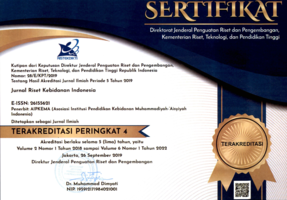Title:
Pengaruh pendidikan ibu terhadap pemilihan alat kontrasepsi Intra Uterine Device (IUD)
Author:
Abstract
Keywords
Full Text:
PDFReferences
Abasiattai AM; Bassey EA; Udoma EJ. 2008. Profile of Intrauterine Contraceptive Device Acceptors at the University of Uyo Teaching Hospital, Uyo, Nigeria. Annals of African Medicine
Alemayehu, M., Belachew, T., Tilahun, T., 2012. Factors associated with utilization of long acting and permanent contraceptive methods among married women of reproductive age in Mekelle town, Tigray region, north Ethiopia. BMC Pregnancy and Childbirth 12. https://doi.org/10.1186/1471-2393-12-6
Anguzu, R., Tweheyo, R., Sekandi, J.N., Zalwango, V., Muhumuza, C., Tusiime, S., Serwadda, D., 2014. Knowledge and attitudes towards use of long acting reversible contraceptives among women of reproductive age in Lubaga division, Kampala district, Uganda. BMC Research Notes 7, 153. https://doi.org/10.1186/1756-0500-7-153
Badan Kependudukan dan Keluarga Berencana Nasional (BKKBN). 2017. Laporan Akuntabilitas Kinerja Instansi Pemerintah 2017.
Berry-Bibee, E.N., Tepper, N.K., Jatlaoui, T.C., Whiteman, M.K., Jamieson, D.J., Curtis, K.M., 2016. The safety of intrauterine devices in breastfeeding women: a systematic review. Contraception 94, 725–738. https://doi.org/10.1016/j.contraception.2016.07.006
Čepulienė, R., Renata Sveikatienė, Gutauskas, K., Vanagienė, V., 2012. Factors Influencing Women’s Preference to Select a Combined Hormonal Contraceptive Method: A Cross-Sectional Survey in Lithuania. Medicina 48, 63. https://doi.org/10.3390/medicina48080063
Chakraborty, N.M., Murphy, C., Paudel, M., Sharma, S., 2015. Knowledge and perceptions of the intrauterine device among family planning providers in Nepal: a cross-sectional analysis by cadre and sector. BMC Health Services Research 15. https://doi.org/10.1186/s12913-015-0701-y
Eeckhaut, M.C.W., Sweeney, M.M., Gipson, J.D., 2014. Who Is Using Long-Acting Reversible Contraceptive Methods? Findings from Nine Low-Fertility Countries. Perspectives on Sexual and Reproductive Health 46, 149–155. https://doi.org/10.1363/46e1914
Infodatin Info datin. 2014. Pusat Data dan informasi Kementrian Kesehatan RI Situasi dan Analisis Keluarga Berencana. http://www.depkes.go.id
Laporan Kinerja Instansi Pemerintah. 2015. Badan Kependudukan dan Keluarga Berencana Nasional
Lindh, I., Andersson Ellstrom, A., Blohm, F., Milsom, I., 2010. A longitudinal study of contraception and pregnancies in the same women followed for a quarter of a century. Human Reproduction 25, 1415–1422. https://doi.org/10.1093/humrep/deq095
Notoatmodjo Soekidjo. 2010. Metodologi Penelitian Kesehatan. Jakarta: Rineka Cipta.
Proverawati, Atikah, dkk. 2010. Panduan Memilih Kontrasepsi. Yogyakarta: Nuha Medika.
Sköld, A., Larsson, M., 2012. Contraceptive use during the reproductive lifecycle as reported by 46-year-old women in Sweden. Sexual & Reproductive Healthcare 3, 43–47. https://doi.org/10.1016/j.srhc.2011.11.004
Xu, X., Macaluso, M., Frost, J., Anderson, J.E., Curtis, K., Grosse, S.D., 2011. Characteristics of users of intrauterine devices and other reversible contraceptive methods in the United States. Fertility and Sterility 96, 1138–1144. https://doi.org/10.1016/j.fertnstert.2011.08.01
Winarno.2009.Kewarganegaraan Indonesia dari Sosiologis Menuju Yuridis .Bandung: CV Alfabeta
DOI: https://doi.org/10.32536/jrki.v3i2.58
Article Metrics
Abstract view : 4710 timesPDF - 1021 times
Cited By
Refbacks
- There are currently no refbacks.
Copyright (c) 2020 Jurnal Riset Kebidanan Indonesia
Jurnal Riset Kebidanan Indonesia
Indexing by:
Diterbitkan oleh:
AIPKEMA (Asosiasi Institusi Pendidikan Kebidanan Muhammadiyah-'Aisyiyah Indonesia)
Universitas ‘Aisyiyah Yogyakarta, Jl. Siliwangi (Ring Road Barat) No. 63, Nogotirto, Gamping, Sleman, Yogyakarta 55292.
Telp. (0274) 4469199; CP: 081236093816; Email: aipkemajrki@gmail.com; dewik.2011@gmail.com

This work (Jurnal Riset Kebidanan Indonesia) is licensed under a Creative Commons Attribution-ShareAlike 4.0 International License.










 Abstract views : 4710
|
Abstract views : 4710
| PDF views : 1021
PDF views : 1021


